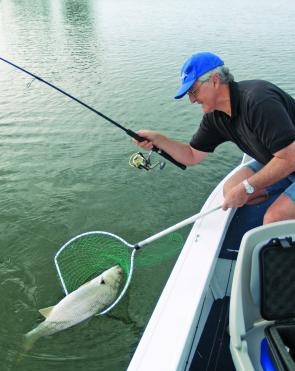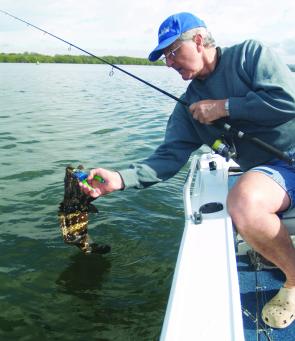The estuary fishing should be flourishing this month, with less nervous eying of the water temperature gauge and more confident casting for a wide range of species.
A lot of the action should be occurring in the mid to lower reaches for whiting, bream, flathead and school jewfish, and in the upper freshwater sections for bass.
After the big January fish kills it will be interesting to see just how far the Richmond River has recovered. There’s no better time to find out than now and early indications are very promising.
October marks the start of the river whiting season proper, with numbers of quality fish to around 40cm increasing daily in North Creek at Ballina and along the deeper flats from Burns Point upstream to about Wardell. The shallower Evans and Brunswick rivers will also fish well early in the season.
The traditional Richmond strategy of anchoring in about 5m in a strong run and fishing live bloodworms on hefty sinkers and long traces produces bag-limit catches of lip-smacking quality fillets.
But you can bet a bucket of bloodworms to a Bubble Pop that a hail of poppers will rain on local waterways as soon as someone whispers the word ‘whiting’, as will be the case on almost every waterway in the State over coming weeks.
It should also be a good season for popping for bream as the prawns grow larger and flick out of the sand on the tides and the schools of bait gather along the banks.
It’s also the time when marauding gangs of highly mobile juvenile GTs and big-eye trevally start their smashing forays into the bait.
I learnt a long time ago in the tropics that it’s futile and frustrating to dash after these fish; you see them ripping into the bait on the opposite bank, charge towards the melee and by the time you get there, the fish have busted up back where you were.
It’s far better to watch the feeding fish for a while, track their path and then try to intercept them, or to set up an ambush where the bait is thickest and where the trevally have a chance to herd up their prey against a bank or the shallows.
Although these fish do take poppers, tiny chrome slugs to 10g or small soft stickbaits tend to catch way more in subsurface presentations.
The bigger GTs to 4kg or more also require some skilled boat manoeuvring and it’s often best to fire up the outboard to take off after a rampaging fish, especially if there’s any line-shredding structure about.
Even so, it’s often impossible to stop the bigger fish on light tackle – but there’s something awe-inspiring about watching a big (for the river!) trevor, stripping line against a small reel’s screaming drag, charging way into the backs of the mangrove snags and seeing sticks and leaves flying everywhere.
There could also be some antics among the snags farther upstream as the bass settle into their Summer homes.
A lot of their early-season diet revolves around aquatic prey such as small herring, mullet fry and other tiny fish as well as shrimps, black crabs and other crustaceans along the banks.
But as October progresses and land and water temps climb, insect life becomes more prevalent and there should be plenty of bass feeding up big on nymphs, emergents and any flying critter that ends up on the surface.
Late in the month you can also add baby water dragons and skinks to that mix so you can try a whole bundle of lure types and probably have success with plenty.
There’s no better time to be chasing hungry bass than when the silky oaks blossom into golden sprays and the jacarandas pulse lilac, and that’s all happening this month.
The river and creeks upstream and slightly down from Lismore should be firing well and so should the river around Casino, although after the January flood remodelled the banks, it’ll be an interesting adventure there.
Back out on the briny, the snapper fishos will be heading a bit wider, weaving between the lingering southbound humpback whales. Some good cobia action is also very likely, along with bonito and increasing numbers of mackerel tuna.
There’ll also be a picket fence of snapper trap headgear to negotiate out wider, with the possibility of some early mahi mahi hanging nearby on the days when the current drags a few float bubbles below the surface.
Kings should be ganging up on the hard bottom with rats in close and better fish from about 50 fathoms out, where most of the pearl perch will also be spread out.
The current can get a little fierce some days but at least it’s warm water and brings the promise of the new season of tropical pelagics.
And that warm water will eventually work its way to the beaches, sending the salmon packing southwards.
Reads: 2127
Freshly retired from Frogleys Offshore, Wayne Lodington now has plenty of time to terrorise the Ballina school jew population.

There’s always the chance of a few early-season warm-water fish such as this estuary cod, which was carefully released. Remember, all estuary cod are protected in NSW.




